

Whale Watching
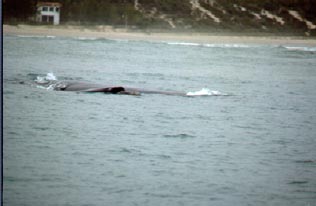 What
is it?
What
is it?
Whale watching is a way of ecotourism and it is the
observing or contemplation of these animals, directly in their natural
habitat, being necessary some studies and patience, because it is
necessary knowing when and where to find them, because they are migratory
animals, being at different places at any time. This kind of leisure has
been becoming one of the most important divisions of ecotourism all around
the world.
Hunt and extinction
The hunting of whales is almost
so antique as navigation history, but with modern resources, the number of
these setaceous has reduced so much that so many species are threatened
from extinction.
Nowadays it is calculated the existence of around 1.000
blue whales, 85.000 fin whales, 12.000 sei whales,
For the protection of the whales it was created the
International Whale Commission (CBI) that in 1986 declared a moratoria to
the commercial hunt.
There still are two more sanctuaries created by CBI, that
are the sanctuary of the Indic Ocean (1970) and the sanctuary of the
Antarctic Ocean (1994), but these administrative ways of protection doesn't
avoid that at Japan they have been hunting around 400 mink whales per year.
So the importance of conscious about the necessity of
preserving these spectacular mammals, being relevant the development of
the observing tourism, that besides bringing more conscious, can also
bring economic power for the cause.
Observing Regulations
In some countries there still
are regulation for "whale watching".
Places for practicing "whale watching" - Whale Watching in Brazil
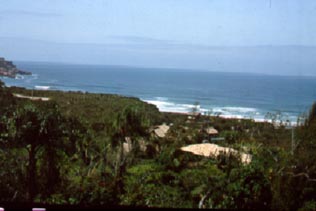 There are a lot of places at the world where "whale
watching" is practiced. In Brazil this practiced has been growing a
lot for the peculiarities of your coast, which besides being of big
extension presents good opportunities of the sea visualization for this
sport.
There are a lot of places at the world where "whale
watching" is practiced. In Brazil this practiced has been growing a
lot for the peculiarities of your coast, which besides being of big
extension presents good opportunities of the sea visualization for this
sport.
The main places for practicing this modality in Brazil are
at Abrolhos (BA) and Praia do Forte (BA), where the jubarte whales can be seen; Rose Beach (SC),
for seeing franca whales and Arraial do Cabo (RJ), for seeing
Bryde whales.
Better period
The
best period for seeing whales in Brazil is at the cold and starting of
spring, more exactly from June to September, when a lot of species come to
the Brazilian coasts for procreation and breast-feeding of the youngs.
 Franca
Whales (Eubalaena australis)
Franca
Whales (Eubalaena australis)
Description: the Right whales are
setaceous that can reach more than 17 m, and the females are bigger than
the males ones. They can height 60 ton- females and 45 ton males.
Identification: the characteristic
"squirt" in a "v" way; they have callus or "warts"
at the high or side of their heads, which proper the formation of "cracas"
colonies that give them a white color hat can be seen in a big distance.
Reproduction: The reproductive
period is mainly at the south coast of Brazil an at the South African
Coast between June and December, when there are breeding and youngs are
born as a result of the last year breeding. The youngs are born around 5 m
and height from 4 to 5 ton.
As the hunting prohibition there is also
noticed the increasing of breeding at these regions and the borning of
youngs.
Feeding: the franca whales eat
small crustaceans as "krill", using the mouth's fin as a filter,
consuming ton of these animals in a small period.
The food area is not known, but we can be
sure that it is at the Antarctic area. Interesting to be noticed is that
the franca whales don't eat when they are at reproduction stage, consuming
the acquired reserves. Franca Whale Project:
This project was created in 1981 by a
volunteer group and has as main objective guarantying the surviving and
recuperation of franca whales population at Brazilian waters.
The Franca Whale Project is nowadays
managed by Brazil's national management of the IWC- International World
Coalition, working in the scientific investigation and the monitoring of
these whales population, and also develops an environmental education for
the public conscious about avoiding the annoying of the animals.
It is located at the "Praia do
Rosa", Imbituba County, Santa Catarina.
More information: "Projeto Baleia
Franca" (www.baleiafranca.org.br)
Jubarte Whales (Megaptera novaeangliae)

Description:
The Humpback Whales are cetaceans that can reach around 16 meters e
weigh around 35 to 40 tons.
Identification:
They are easily identified by their big chest natators, if compared to
their body and costume of going out of water, with marvelous dives. They
are also different because of their tales that they show a long
time out of water.
Reproduction: The reproductive period is, in Brazilian coasts, from June to November, especially in Bahia coasts.
Feeding: They feed from small crustaceans as "krill", eating tons of them each day.
For knowing more: Instituto Baleia Jubarte (www.baleiajubarte.com.br) and Centrotour Operadora (www.centrotour.com.br), one of the main local enterprise for whale watching tourism in Praia do Forte Region (Bahia).
Whales species that can be observed at Brazilian Coasts.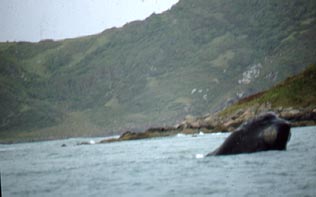
Baleia-jubarte (Megaptera novaeangliae)
Baleia-franca-do-sul (Eubalaena
australis)
Baleia-de-Bryde (Balaenoptera edeni)
Baleia-minke-anã (Balaenoptera acutorostrata)
Baleia-sei (Balaenoptera borealis)
Baleia-fin ( Balaenoptera physalus)
Baleia-azul (Balaenoptera musculus)
The emergent observing tourism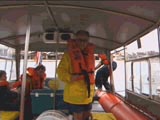
Tourism is considered by many
researches organs as one of the activities divisions that are growing more
in the world, being calculated that more than 180 million people live
directly or indirectly of this activity, moving around the world trillion
of dollars. And for attracting interested people in a lot of distinct
areas, tourism has become divided in segments as: cultural tourism,
religious tourism, sportive tourism, child tourism, third age tourism,
gastronomic tourism, country tourism and ecological tourism or ecotourism.
This last modality has become the one that has been more
developing in the last years, mainly at the countries that are called the
emergent ones, as Brazil, because there still are a lot of natural areas.
Ecotourism is also subdivided in a lot of modalities, but among them, the
observing tourism must be distinct for being one of the emergent ways that
are more calling the attention of naturalists and ecologists, because its
practice involves a lot of important factors for the preservation and
ecology studies. Let's see it.
The observing tourism is a segment of ecotourism where the
ecotourist goes to some natural area, observing its beauty, contemplating
it, or specifically one or some of its elements as birds or mammals, and
as an example, the whales. This kind of ecotourism has practically been
originated from the "photographic safari", which has been
initiated around the century 60 and it is still common, mainly at the
African continent, where the mastofauna permits better photographic
registers. But one of the main factors that provides the development of
the observing tourism is the increasing of ecological conscious and as
consequence the preserving of natural areas, providing place and
opportunities for this kind of activity.
The ways that more are emerging are birding, whale
watching and scenery watching. All of them are interesting ways of leisure
and entertainment The birding is the most antique one, being so developed
at the USA, England, German, Spain and Japan, being calculated that there
are around 80 million birders around the world. It represents a big
economical potential, if we consider that this people are almost all from
developed countries and consequently they have acquisitive power for
international trips.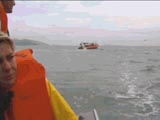
Therefore, the whale watching is a way that is becoming
bigger and bigger, including Brazil, and it can be noticed by the
increasing of special packages for this kind of ecotourism for the coast
of Santa Catarina and the region of Abrolhos-Bahia, where at the end of
winter and beginning of spring groups of franca and jubarte whales come
for breeding, giving us an impressive spectacle. Therefore, in a lot of
the world's places, the whale watching is practiced, being calculated that
there are more than 40 million whale observers, generating a lot of
divisions. By its turn, the scenery watching is emerging because of the
increasing of environmental sensibility and the increasing of the
degradation, what has made small the number of places where natural scenic
beauty can be seen.
The observing Tourism brings a lot of advantages.
So, the emergent observing tourism must have the attention
of the proper organs of tourism, as from the press, enterprise owners,
biologists, ecologists, naturalists etc., mainly in regions that are rich
in natural areas, because it represents a way of touristic, socio-economic
and ecological development, so important for having an environment
ecologically balanced.
Advantages of observing ecotourism:
Minimum environmental impact
Educative character
There isn't age limitation
Provides income for remote places or with small commercial activity
Employs the country mass, giving opportunities for personal development
Incentive hotel and tourism industry
Employs in new activities as guides, ecologues, educators etc.
Collaborates to the principles of sustainable development that is in the Agenda 21.
Sites about the subject:
IFAW – International Fund for Animal Welfare - www.ifaw.org
WDCS - The Whale and Dolphin Conservation Society - www.wdcs.org
Comissão Baleeira International - http://ourworld.compuserve.com/homepages/iwcoffice
Greenpeace do Brasil - www.greenpeace.org.br
Archangel of Seven Seas (Finlândia)
Bar Harbor Whale Museum (EUA)
Deutschen Naturkunde-Museen (Alemanha)
Friday Harbor (EUA)
Hale Kohola Museum (EUA)
Hawaii Wildlife Fund (EUA)
Killer Whale Museum (Austrália)
List of Public Aquariums (Japão)
Museo de la ballena gris, La Paz, Baja California Sur (México)
Nerd World: Museums (EUA)
Projeto Baleia Franca (Brazil)
Rhode Island (EUA)
Sealand Market Oceanarium (Canadá)
Sealand Oceanarium (Canadá)
Sidney Museum (Canadá)
Sidney Museum Beacon Avenue (Canadá)
Smith's Master Index to North American Maritime Museums on the Web (EUA)
The Aquarium (EUA)
The Sperm Whale Project (EUA)
The Virtual Whale Museum (EUA)
The Whale Museum (EUA)
The Whale Museum (EUA)
Twofold Bay at Eden (Austrália)
University of Vermont (EUA)
Vancouver Aquarium (Canadá)
Wal und Mensch (Alemanha)
Whale Museum (Canadá)
Whale Museum (Taiji Town) (Japão)
Whales Village Museum (EUA)
Some pictures from our practice in Brazil










Click here for watching some videos
Texts and Pictures: Antonio Silveira
All Rights Reserved